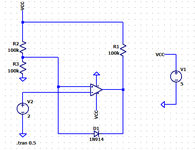sabu31
Advanced Member level 1
Dear All,
I am trying to simulate the overcurrent latch circuit (Application 5) given the datasheet of ACS712.
However, when I am simulating the system in LTSPICE, I am not getting the desired result. I am not able to understand the function of the Diode and Resistance R1. When I remove the diode, the circuit functions as required. What could be the issue?
I am trying to simulate the overcurrent latch circuit (Application 5) given the datasheet of ACS712.
However, when I am simulating the system in LTSPICE, I am not getting the desired result. I am not able to understand the function of the Diode and Resistance R1. When I remove the diode, the circuit functions as required. What could be the issue?
